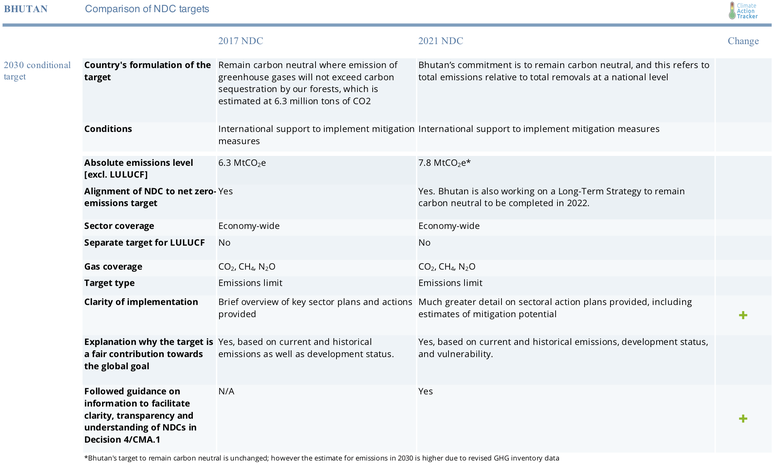Summary
Bhutan’s second NDC, submitted in June 2021, did not change the country’s carbon neutral goal that it’s had since 2009, and has been achieving. However, as a result of the latest inventory data, the ultimate emissions level of this target has increased.
While Bhutan’s goal to remain carbon neutral is admirable, especially given its Least Developed Country status, increasing energy and industry emissions could put Bhutan in a difficult position for its long-term low-carbon transition, risking a breakdown of its carbon neutrality. In the second NDC, Bhutan has provided much greater detail on the types of mitigation measures it seeks to implement, with international support. With this support, it should strive not only to be carbon neutral, but remain net negative.
CAT Analysis of NDC submission

On June 24, 2021, Bhutan submitted its second Nationally Determined Contribution (NDC) to the UNFCCC, reiterating its ambition to be carbon neutral, a target it has had since 2009 and that was also included in its first NDC. Bhutan also provided a more policy, action and timeframe-oriented pathway to continue to respect that target.
While Bhutan’s target remains the same, the effective emissions limit of that target has increased due to the latest inventory data which shows a larger land sector sink. In the first NDC, the net sink was estimated to be 6.3MtCO2e per year and is now 7.8 MtCO2e. We have rated the second NDC as being stronger than the first NDC on the basis of the further detail on mitigation measures Bhutan seeks to implement with international support. With this international support, Bhutan should focus on avoiding emissions growth over the coming decade.
In its second NDC, Bhutan has enhanced its mitigation targets and actions through Low Energy Development Strategies (LEDS). The LEDS were developed for key sectors of agriculture and livestock (food security), human settlement, industries and transport. The total cumulative emissions reduction potential from these sectors has been estimated as approximately 20 MtCO2e between 2021-2030. Several policies and action-based targets have also been laid out for power sector and waste management. It has also expanded its efforts in the land sector.
Bhutan is working on a long-term strategy to remain carbon neutral to 2050, which should be ready in 2022.

Assumptions
Bhutan’s reference year for its carbon neutral goal is 2015, using data from its 3rd National Communication.
To quantify its NDC, we converted the estimate for net LULUCF emissions in its third inventory from SAR to AR4 global warming potential values for the 3 Kyoto gases included in its NDC.
The first NDC used the reference period 2000-2013. We calculated the average for this period from the data in the Third National Communication and it is very close to the new 2015 reference year. In other words, it is the revised estimates for the country’s sink, rather than any change in reference year that accounts for the different in target levels.
Links
Stay informed
Subscribe to our newsletter